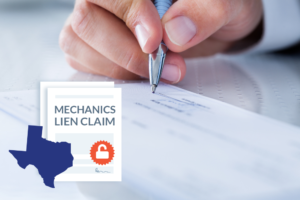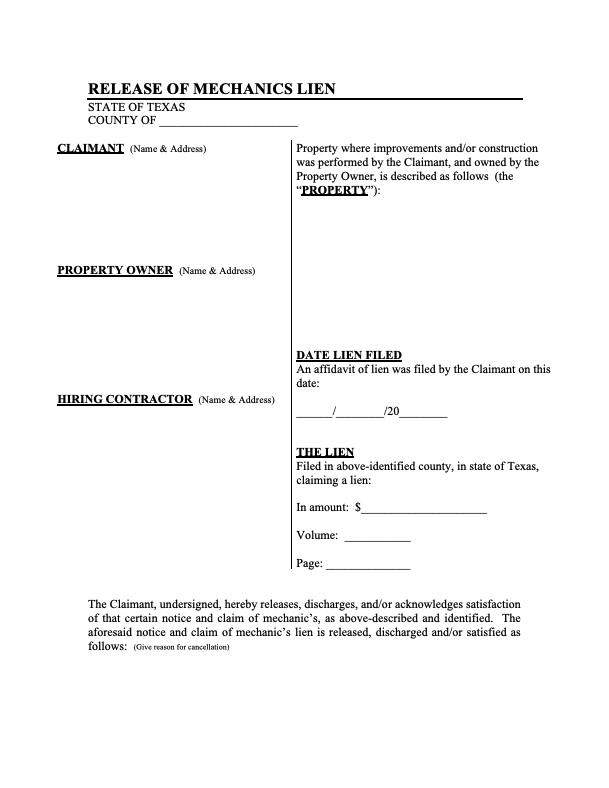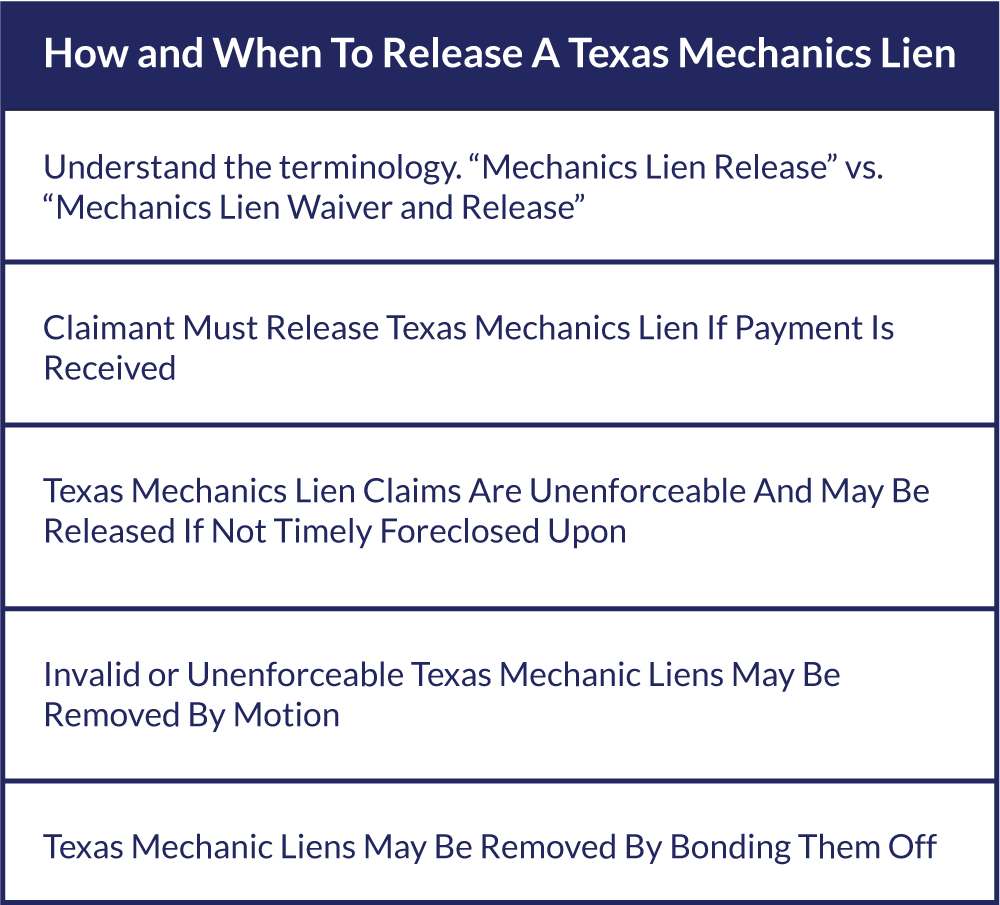
There are various ways to remove a lien claim and discharge it from a property. In this article, we explain the process to release a Texas mechanics lien. The article is relevant to contractors who filed a lien claim, and property owners who want a lien removed.
The process of releasing a Texas mechanic lien, like everything else under Texas mechanics lien law, is unique. Unlike many other states, the Texas statutes present comprehensive guidelines as to who may release a mechanics lien claim, and how. Because a Texas lien may be released by anyone with interest in the property or the lien (under defined circumstances), the release process is relevant to everybody connected to a construction project.
Release of Lien After Payment — Upon Request
Anyone who files a mechanics lien against a project in Texas must release their claim if:
- They receive payment for the claim, and
- A release is requested
Furthermore, the law is clear that a partial release must be recorded in the event of any partial payment. Specifically, Texas Prop. Code §53-152 says:
- When a debt for labor or materials is satisfied or paid by collected funds, the person who furnished the labor or materials shall, not later than the 10th day after the date of receipt of a written request, furnish to the requesting person a release of the indebtedness and any lien claimed, to the extent of the indebtedness paid. An owner, the original contractor, or any person making the payment may request the release.
- A release of lien must be in a form that would permit it to be filed of record.
In some states, a lien claimant must release their lien after getting paid, whether or not someone asks them to. Texas law is different.
In Texas, the mechanics lien claimant does not have an independent duty to release a claim in the event of payment. The duty to release the claim only arises if someone makes a written request to have the lien released. If an interested party doesn’t make a written request for release, the claim could theoretically live on the record books forever with no consequence to the claimant.
The statute is clear that an interested party may request a lien release in the event of any payment. If the payment is only a partial payment, the interested party may request a partial lien release.

Get a free lien release form
Download a Release of Lien form for use in Texas, prepared by construction attorneys to meet the statutory requirements.
Lien release rules can be vague
While Texas statute is clear about who can request the lien release and under what conditions, the statute is surprisingly vague in two important areas.
First, the consequences are not clear for failing to file a lien release after a written request. This may sound nice at first blush to a lien claimant. “No consequences? Why file a release?!” But really, the ambiguity enables owners and contractors to make claim to open-ended general damages. The penalties awarded in a lawsuit are probably worse than a defined penalty.
Contractors, suppliers, or other lien claimants are well served to get a lien release recorded when demand is made and the release is required.
Second, the statute is ambiguous about the actual form to use. The law simply requires it to be “in a form that would permit it to be filed of record.” This could be the source of a lot of headaches. The county recorder offices may have different recording requirements from county-to-county, and oftentimes, the requirements may be arbitrary.
Claimants and county recorder offices alike would likely find success in using a standard general Texas lien release form.
Release If Foreclosure Action is Delayed
Something interesting about Texas’ mechanics lien release procedures is that they specific that the claim may be “discharged” if not timely foreclosed upon. As you’ll see from this discussion, however, the law fails to specify how the claim may be discharged under these circumstances.
A mechanics lien in Texas is a temporary claim against the property that can be made permanent if the claimant files a formal action to foreclose against the claim. If the foreclosure action is not timely filed, §53-157(2) provides that the lien claim may be discharged. Specifically, §53-157(2) provides as follows:
A mechanic’s lien or affidavit claiming a mechanic’s lien filed under Section 53.052 may be discharged of record by:
…
(2) failing to institute suit to foreclose the lien in the county in which the property is located within the period prescribed by Section 53.158, 53.175, or 53.208;
It’s quite clear, therefore, that a mechanics lien may be discharged if the claim is not timely foreclosed upon. However, the statute is completely silent on who can cause the claim to be discharged, and how the discharged can practically be carried out.
Discharging a lien may require a court action
Most likely, anyone with an interest in the construction project, such as an owner, lender, or general contractor, are likely in the position to get a mechanics lien discharged if it is not timely foreclosed upon. However, it’s not likely that they can just show up at the recorders office with a release document for recording. This is unlikely because the recorder would be incapable of determining if the lien claim was truly expired, as the foreclosure period requires a detailed factual determination.
Therefore, while the statute fails to explain how a lien may be discharged in the event the foreclosure period expires, it is most likely required that the interested parties initiate a motion procedure to have the lien declared expired and ordered released.
Release of An Invalid or Unenforceable Lien
There are certain, defined circumstances when an interested party may petition the court by motion to have a Texas mechanics lien declared invalid or unenforceable.
We say that the circumstances are “certain” and “defined,” because the statute specifically sets forth that the “grounds for objecting to the validity or enforceability of the…lien…are limited to the following,” and thereafter enumerates 7 specific situations. Potential movers should note that there are bond requirements to file this motion, which may put the risk of filing quite high.
The 7 specific situations are as follows. An interested party may petition to release a lien if:
- A Notice of Claim was not delivered to the owner or original contractor as required in the lien filing process
- The lien claim affidavit did not comply with the requirements
- Notice of the lien’s filing was not delivered to the owner or original contractor as required in the lien filing process
- Retainage is claimed in the lien, the retainage period for claims expired, and the owner took all require precautions
- The owner deposits all sums in controversy into the registry of the court and has no additional liability to the claimant (i.e. likely, the claimant and contractor would continue to argue over who is due the money)
- The lien was against homestead property and the appropriate procedures and forms were not used
- A claimant had executed a valid and enforceable lien waiver for the claim
Lien removal due to filing errors
If you read those closely, you’ll notice that most of the 7 defined circumstances allowing a motion to declare a lien invalid relate to errors in the lien filing process.
A Texas mechanics lien cannot be summarily invalidated because the “claimant didn’t do the work,” that the “workmanship was poor,” the “parties did not agree to the disputed amount,” etc.
Instead, the reasons almost always relate to some procedural or practical mistake made in the filing process. This, by the way, is why it’s so important to get your mechanics lien filed reliably and to avoid Do-It-Yourself forms. Making a mistake when filing a lien can be incredibly costly.
Burden of proof
The law does not specifically allow an interested party to file a motion to remove an expired mechanics lien, leaving it probable that a motion could be employed to have an expired lien removed, but certainly not straight-forward.
According to the statute, the following burdens would apply if a lien removal motion was filed. At the hearing on the motion, the burden is on:
- The claimant to prove that the notice of claim and affidavit of lien were furnished to the owner and original contractor as required by this chapter; and
- The petitioner to establish that the lien should be removed for any other ground authorized by this section.
It’s important for claimants to keep detailed proof that their notices and the notice of mechanics lien filing is served on the owner and/or original contractor according to the statutory requirements. This is more nuanced than first meets the eye, as we explained in How to Send A Notice to Owner and What to Track When Sending A Notice.
It’s also interesting to note that a motion may be used to remove a Texas mechanics lien when the owner makes a deposit into the registry of the court to cover any potential liability on the claim. The owner, in order words, can simply throw a bunch of cash (from the contract) with the court, and let the parties in disagreement fight over who is owed the money.
In the meantime, the owner will be off the hook to the general contractor and the lien will be ordered removed. This is a very viable option for the owner, as is the next option to remove the a Texas Mechanics Lien: Bonding it off.
Release By Bonding Off a Lien
The final method for removing a Texas mechanics lien is to have the lien “bonded off.” The requirements and procedure to bond off a mechanics lien claim is set forth within an entire chapter from the lien law statutes, in Subchapter H: Bond to Indemnify Against Lien.
The first provision nicely sums up the way this process is used:
- If a lien, other than a lien granted by the owner in a written contract, is fixed or is attempted to be fixed by a recorded instrument under this chapter, any person may file a bond to indemnify against the lien.
- The bond shall be filed with the county clerk of the county in which the property subject to the lien is located.
- A mechanic’s lien claim against an owner’s property is discharged after:
- A bond that complies with Section 53.172 is filed;
- The notice of the bond is issued as provided by Section 53.173; and
- The bond and notice are recorded as provided by Section 53.174.
After a Texas mechanics lien is filed, an owner, general contractor, or other interested person may acquire a “lien bond” from a qualified surety (i.e. “a corporate surety authorized and admitted to do business in Texas and licensed by Texas”). The lien bond must be filed with the county clerk, and must be accompanied by certain required notices.
Getting a lien release bond is not as simple as it sounds, and can be quite expensive. But once the steps completed, the mechanics lien will be discharged. This, however, simply discharges the mechanics lien from the property, but it does not settle the dispute or the debt. The lien claimant still has substantial rights against the new bond, and in fact, this is sometimes preferable to the lien against the property. Bonding off a mechanics lien can actually be good news for a claimant.
A Texas mechanics lien, therefore, can be formally removed from the property records and released through a lien bond. This will release the property from being treated as collateral, and free up the property for further use. However, the lien claimant will not sacrifice their rights, and will have the ability to claim payment from the surety.

Conclusion
Whenever a Texas mechanics lien is filed, it will ultimately, one way or another, be released. The process of getting the lien released will depend on circumstances, and it’s important that those interested in the lien get familiar with all of the processes and follows the process relevant to their situation closely. There’s nothing more aggravating than running into an old, stale lien claim unknowingly on the books for years that must be cleared up (fast) to push through a desired transaction.
Ideally, the parties will resolve their differences and release a mechanics lien claim mutually after payment of the disputed amount. However, if this is not possible or if the dispute is too great, there are other methods. A property owner can have the lien declared invalid, guarantee the lien claim with cash, or bond off the lien.

